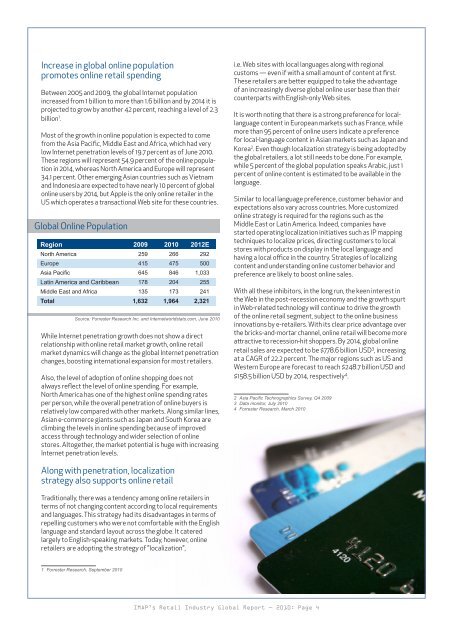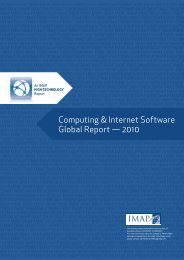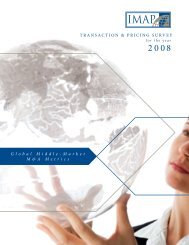Retail industry global report 2010.pdf - IMAP
Retail industry global report 2010.pdf - IMAP
Retail industry global report 2010.pdf - IMAP
- No tags were found...
You also want an ePaper? Increase the reach of your titles
YUMPU automatically turns print PDFs into web optimized ePapers that Google loves.
Increase in <strong>global</strong> online populationpromotes online retail spendingBetween 2005 and 2009, the <strong>global</strong> Internet populationincreased from 1 billion to more than 1.6 billion and by 2014 it isprojected to grow by another 42 percent, reaching a level of 2.3billion 1 .Most of the growth in online population is expected to comefrom the Asia Pacific, Middle East and Africa, which had verylow Internet penetration levels of 19.7 percent as of June 2010.These regions will represent 54.9 percent of the online populationin 2014, whereas North America and Europe will represent34.1 percent. Other emerging Asian countries such as Vietnamand Indonesia are expected to have nearly 10 percent of <strong>global</strong>online users by 2014, but Apple is the only online retailer in theUS which operates a transactional Web site for these countries.Global Online PopulationRegion 2009 2010 2012ENorth America 259 266 292Europe 415 475 500Asia Pacific 645 846 1,033Latin America and Caribbean 178 204 255Middle East and Africa 135 173 241Total 1,632 1,964 2,321Source: Forrester Research Inc. and Internetworldstats.com, June 2010While Internet penetration growth does not show a directrelationship with online retail market growth, online retailmarket dynamics will change as the <strong>global</strong> Internet penetrationchanges, boosting international expansion for most retailers.Also, the level of adoption of online shopping does notalways reflect the level of online spending. For example,North America has one of the highest online spending ratesper person, while the overall penetration of online buyers isrelatively low compared with other markets. Along similar lines,Asian e-commerce giants such as Japan and South Korea areclimbing the levels in online spending because of improvedaccess through technology and wider selection of onlinestores. Altogether, the market potential is huge with increasingInternet penetration levels.i.e. Web sites with local languages along with regionalcustoms — even if with a small amount of content at first.These retailers are better equipped to take the advantageof an increasingly diverse <strong>global</strong> online user base than theircounterparts with English-only Web sites.It is worth noting that there is a strong preference for locallanguagecontent in European markets such as France, whilemore than 95 percent of online users indicate a preferencefor local-language content in Asian markets such as Japan andKorea 2 . Even though localization strategy is being adopted bythe <strong>global</strong> retailers, a lot still needs to be done. For example,while 5 percent of the <strong>global</strong> population speaks Arabic, just 1percent of online content is estimated to be available in thelanguage.Similar to local language preference, customer behavior andexpectations also vary across countries. More customizedonline strategy is required for the regions such as theMiddle East or Latin America. Indeed, companies havestarted operating localization initiatives such as IP mappingtechniques to localize prices, directing customers to localstores with products on display in the local language andhaving a local office in the country. Strategies of localizingcontent and understanding online customer behavior andpreference are likely to boost online sales.With all these inhibitors, in the long run, the keen interest inthe Web in the post-recession economy and the growth spurtin Web-related technology will continue to drive the growthof the online retail segment, subject to the online businessinnovations by e-retailers. With its clear price advantage overthe bricks-and-mortar channel, online retail will become moreattractive to recession-hit shoppers. By 2014, <strong>global</strong> onlineretail sales are expected to be $778.6 billion USD 3 , increasingat a CAGR of 22.2 percent. The major regions such as US andWestern Europe are forecast to reach $248.7 billion USD and$158.5 billion USD by 2014, respectively 4 .2 Asia Pacific Technographics Survey, Q4 20093 Data monitor, July 20104 Forrester Research, March 2010Along with penetration, localizationstrategy also supports online retailTraditionally, there was a tendency among online retailers interms of not changing content according to local requirementsand languages. This strategy had its disadvantages in terms ofrepelling customers who were not comfortable with the Englishlanguage and standard layout across the globe. It cateredlargely to English-speaking markets. Today, however, onlineretailers are adopting the strategy of "localization",1 Forrester Research, September 2010<strong>IMAP</strong>’s <strong>Retail</strong> Industry Global Report — 2010: Page 4








